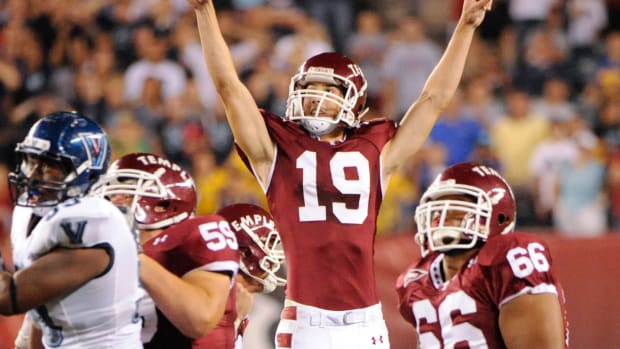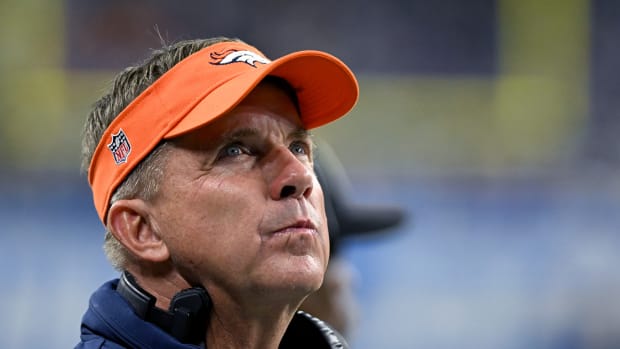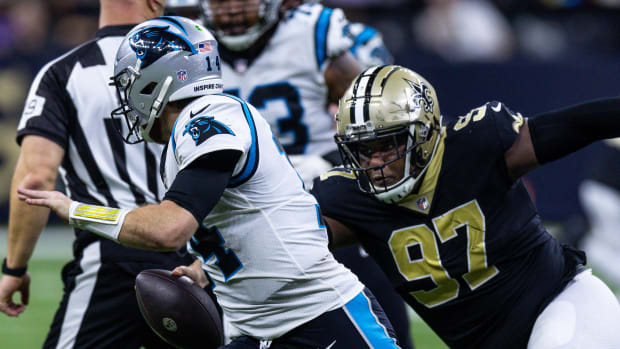Film Room: 5 Plays Exposing How Predictable Broncos' OC Pat Shurmur has Become
There were a lot of issues with the Denver Broncos' offensive output in their 22-9 loss to the Kansas City Chiefs. With quarterback Teddy Bridgewater unable to lead an accurate passing attack and an offensive line getting controlled at the point of attack, the only good thing Denver had going was a consistent running game thanks to a rookie running back breaking tackles.
The Broncos' play-calls and sequencing from offensive coordinator Pat Shurmur were also problematic. There were a handful of plays that stood out for a few different reasons when breaking down the film.
Some of them can be boiled down to the design, while others stem from the play prior. Whatever the reason, even with the offense not executing, Shurmur has to do a better job.
Play 1 | First Quarter | 6:18
Situation: 2nd-&-9
There are a few questions about this first play, which came after a one-yard run on first down. First, the design is terrible and sets the offense up for failure.
The formation draws the Chiefs closer to the line of scrimmage as Denver has shown it likes to run out of this formation. It was understandable to try and catch Kansas City off guard with a pass, but the route combination was a disaster.
WR Jerry Jeudy came across formation before the snap and just ended up running a flat route, as did RB Javonte Williams after a brief look as a blocker. Then, at the top of the formation, WR Tim Patrick and TE Noah Fant are running curl routes finding themselves only a couple of yards apart while WR Courtland Sutton runs a slant that lands him right behind the first layer of the defense.
If you want to try and catch the defense off guard with a pass out of this formation, your route combination can't be three that resolve just behind the pulled-up defense. This simplistic design looked like one an amateur would draw up on Madden.
Play 2 | First Quarter | 1:27
Situation: 1st-&-10
Next up is a play that has nothing to do with the play design. In fact, Denver showed it could run effectively from this formation with the blocking set up the same way. How do we know that? Denver ran practically the same play just before this one, but reversed.
Running the same play back-to-back rarely works, especially when the defense expects it. The Chiefs saw this and played the run right from the start, and one of their linebackers read it and got right into the gap.
This is bad sequencing from the play-caller, and with it being 1st-&-10, it would've been a good look to run a quick play-action rollout with the two receivers on one defender at the top of the screen.
Play 3 | Second Quarter | 9:04
Situation: 2nd-&-7
Not only was this a bad play by Bridgewater, but the design was also terrible. There is never a circumstance where you are drawing up a play and should think, "Yes, let's keep Patrick in to pass protect." Yet, that's what we have here.
Wanting to take the shot is fine, as is trying to catch the opponent off guard with a play-action look. However, you don't do it by only having two receivers running routes. If you wanted to sell the play-action, then line up in the formations you typically run the ball out of.
Denver has a high pass rate out of 11-personnel, and the Chiefs never bought into the play-action as a result. Bridgewater ended up throwing it up as the interior offensive line broke down and nearly had this pass picked off. Bad design, bad call, and terrible execution.
Play 4 | Second Quarter | 6:06
Situation: 1st-&-10
This wasn't a terrible play-call, or bad design for that matter. What it does, though, is break a general rule of thumb when it comes to roll-out passes. You don't run roll-outs to the short end of the field, as Denver does here.
Sometimes you can get away with it, but the timing and design have to be perfect. Neither was the case here, although the design wasn't bad. The route combination could have been cleaner to use the spacing better and help generate more space, potentially, for TE Albert Okwuegbunam after the catch.
Play 5 | Second Quarter | 1:22
Situation: 3rd-&-4 | 4th-&-2
As a special prize, it's time to focus on the play sequencing that closed out the Broncos' 20-play drive that sucked 11:09 off the clock but ended with zero points. The question here is, did the Broncos intend to go for it before getting to fourth down?
The result implies the answer is affirmative based on how it played out. The third-down play call was actually a good design, but Bridgewater was way late to try and connect with Patrick, who had a chance to make the first down. However, if the Broncos were always going for it on fourth down, they should have kept it on the ground, which is basically how they drove so deep into Chiefs' territory.
If the Broncos failed, they'd have minimized their potential for a turnover while maximizing the calls to their advantage. So the third-down call was a good design, just bad sequencing.
Now, the Broncos followed up this botched third-down is why I'm confident they intended to go for it from the start. Denver didn't call a timeout. If the Broncos had to think about it, even if it was an easy decision, they should have called time-out to give the offense more time to get the right play call in. That should have been decided well before the offense lined up.
Not calling a time-out led to the issues on the fourth-down call. There were many drawbacks to the design and the call came at the worst time. It confused multiple players on offense, which adds to why a time-out should have been called.
Also, with it being fourth down, that's when you should call the pass play on a creative design to get someone open quickly. That would've required Shurmur to go away from his predictable play-calling and for Vic Fangio to use the time-outs instead of wasting them on failed challenges.
Follow Erick on Twitter @ErickTrickel.
Follow Mile High Huddle on Twitter and Facebook.
Subscribe to Mile High Huddle on YouTube for daily Broncos live-stream podcasts!




